Articles
- Page Path
- HOME > Korean J Community Nutr > Volume 19(2); 2014 > Article
-
Research Article
- Dietary Intake Status among Korean Female Breast Cancer Survivors
- Myungsook Park, Eunkyung Hwang, Hyeong-Gon Moon, Dong-Young Noh, Jung Eun Lee
-
Korean Journal of Community Nutrition 2014;19(2):163-175.
DOI: https://doi.org/10.5720/kjcn.2014.19.2.163
Published online: April 30, 2014
1Department of Food and Nutrition, Sookmyung Women's University, Seoul, Korea.
2Breast Care Center, Seoul National University Hospital, Seoul, Korea.
3Department of Surgery and Cancer Research Institute, Seoul National University College of Medicine, Seoul, Korea.
- Corresponding author: Jung Eun Lee. Sookmyung Women's University, Cheongpa-ro, 47-gil 100, Yongsan-gu, Seoul 140-742, Republic of Korea. Tel: (02) 2077-7560, Fax: (02) 710-9479, junglee@sm.ac.kr
Copyright © 2014 The Korean Society of Community Nutrition
This is an Open-Access article distributed under the terms of the Creative Commons Attribution Non-Commercial License (http://creativecommons.org/licenses/by-nc/3.0/) which permits unrestricted non-commercial use, distribution, and reproduction in any medium, provided the original work is properly cited.
- 404 Views
- 4 Download
- 6 Crossref
Abstract
-
Objectives
- We aimed to evaluate dietary intake among female breast cancer survivors in a cross-sectional study.
-
Methods
- A total of 127 women who had breast cancer surgery at least 6 months before baseline were included. Dietary intake of female breast cancer survivors was assessed through self-reported 3 day-dietary records. To compare dietary intake between breast cancer survivors and general female population without cancer, we selected the 1:4 age matched women from the 2011 Korean National Health and Nutrition Examination Survey (KNHANES). In the KNHANES, participants were asked about their dietary intake using the 24-hour dietary recalls. We also examined whether dietary intake varied by age group, cancer stage, or time since surgery among breast cancer survivors. We used the generalized linear model to compare their dietary intakes.
-
Results
- Intakes of total energy, beta-carotene, folate, vitamin C, plant iron and fruits were lower among breast cancer survivors with longer time since surgery compared to those with shorter time (p < 0.05). Breast cancer patients with higher stage at diagnosis tended to consume less legumes (p = 0.01) than those with lower stage. When we compared dietary intake between breast cancer survivors and the general female population without cancer, breast cancer survivors were more likely to consume most of macro- and micro-nutrients in larger quantity (p < 0.05) and adhere to healthier diet characterized by higher intakes of legumes, seed and nuts, vegetables and fishes and shells than the general female population who never had been diagnosed with cancer (p < 0.05).
-
Conclusions
- Our study results suggested that the intakes of nutrients and foods varied by time since surgery and cancer stage among breast cancer survivors and dietary intakes among breast cancer survivors differed from that in the general population. Further prospective studies are warranted to explore the association between dietary intakes of specific food items and survival among Korean breast cancer survivors.
- 1. Barrera R. Nutritional support in cancer patients. JPEN J Parenter Enteral Nutr 2002; 26: 5 suppl. S63-S71.ArticlePubMed
- 2. Beasley JM, Newcomb PA, Trentham-Dietz A, Hampton JM, Bersch AJ, Passarelli MN, Holick CN, Titus-Ernstoff L, Egan KM, Holmes MD, Willett WC. Post-diagnosis dietary factors and survival after invasive breast cancer. Breast Cancer Res Treat 2011; 128(1): 229-236.ArticlePubMedPMCPDF
- 3. Belle FN, Kampman E, McTiernan A, Bernstein L, Baumgartner K, Baumgartner R, Ambs A, Ballard-Barbash R, Neuhouser ML. Dietary fiber, carbohydrates, glycemic index, and glycemic load in relation to breast cancer prognosis in the heal cohort. Cancer Epidemiol Biomarkers Prev 2011; 20(5): 890-899.ArticlePubMedPMCPDF
- 4. Bozzetti F, Migliavacca S, Scotti A, Bonalumi M, Scarpa D, Baticci F, Ammatuna M, Pupa A, Terno G, Sequeira C. Impact of cancer, type, site, stage and treatment on the nutritional status of patients. Ann Surg 1982; 196(2): 170.ArticlePubMedPMC
- 5. Brown J, Byers T, Thompson K, Eldridge B, Doyle C, Williams AM. Nutrition during and after cancer treatment: a guide for informed choices by cancer survivors. CA Cancer J Clin 2001; 51(3): 153-181.ArticlePubMed
- 6. Carey LA, Perou CM, Livasy CA, Dressler LG, Cowan D, Conway K, Karaca G, Troester MA, Tse CK, Edmiston S. Race, breast cancer subtypes, and survival in the carolina breast cancer study. JAMA 2006; 295(21): 2492-2502.ArticlePubMed
- 7. Chlebowski RT, Blackburn GL, Thomson CA, Nixon DW, Shapiro A, Hoy MK, Goodman MT, Giuliano AE, Karanja N, McAndrew P, Hudis C, Butler J, Merkel D, Kristal A, Caan B, Michaelson R, Vinciguerra V, Del Prete S, Winkler M, Hall R, Simon M, Winters BL, Elashoff RM. Dietary fat reduction and breast cancer outcome: interim efficacy results from the women's intervention nutrition study. J Natl Cancer Inst 2006; 98(24): 1767-1776.PubMed
- 8. Clemons M, Goss P. Estrogen and the risk of breast cancer. N Engl J Med 2001; 344(4): 276-285.ArticlePubMed
- 9. Demark-Wahnefried W, Hars V, Conaway MR, Havlin K, Rimer B, McElveen G, Winer E. Reduced rates of metabolism and decreased physical activity in breast cancer patients receiving adjuvant chemotherapy. Am J Clin Nutr 1997; 65(5): 1495-1501.ArticlePubMed
- 10. Dong JY, Qin LQ. Soy isoflavones consumption and risk of breast cancer incidence or recurrence: a meta-analysis of prospective studies. Breast Cancer Res Treat 2011; 125(2): 315-323.ArticlePubMedPDF
- 11. GLOBOCAN. GLOBOCAN 2012 cancer fact sheet, International agency for research on cancer. 2012; cited December 20, 2013]. Available from http://globocan.iarc.fr/Pages/fact_sheets_cancer.aspx.
- 12. Goodwin PJ, Ennis M, Pritchard KI, Trudeau M, Hood N. Risk of menopause during the first year after breast cancer diagnosis. J Clin Oncol 1999; 17(8): 2365-2365.ArticlePubMed
- 13. Grindel C, Cahill C, Walker M. Food intake of women with breast cancer during their first six month of chemotherapy. Oncol Nurs Forum 1989; 16(3): 401-407.PubMed
- 14. Hunter DJ, Spiegelman D, Adami HO, Beeson L, van den Brandt PA, Folsom AR, Fraser GE, Goldbohm RA, Graham S, Howe GR. Cohort studies of fat intake and the risk of breast cancer-a pooled analysis. N Engl J Med 1996; 334(6): 356-361.ArticlePubMed
- 15. Jung KW, Won YJ, Kong HJ, Oh CM, Seo HG, Lee JS. Cancer statistics in Korea: incidence, mortality, survival and prevalence in 2010. Cancer Res Treat 2013; 45(1): 1-14.ArticlePubMedPMC
- 16. Korean Breast Cancer Society. Breast cancer knowledge. 2013; cited 2013 September 26]. Available from http://www.kbcs.or.kr/journal/common_sense_14.html.
- 17. Kroenke CH, Fung TT, Hu FB, Holmes MD. Dietary patterns and survival after breast cancer diagnosis. J Clin Oncol 2005; 23(36): 9295-9303.ArticlePubMed
- 18. Kroenke CH, Kwan ML, Sweeney C, Castillo A, Caan BJ. High- and low-fat dairy intake, recurrence, and mortality after breast cancer diagnosis. J Natl Cancer Inst 2013; 105(9): 616-623.ArticlePubMedPMC
- 19. Kuiper GG, Lemmen JG, Carlsson B, Corton JC, Safe SH, van der Saag PT, van der Burg B, Gustafsson JA. Interaction of estrogenic chemicals and phytoestrogens with estrogen receptor beta. Endocrinology 1998; 139(10): 4252-4263.ArticlePubMed
- 20. Kwan ML, Weltzien E, Kushi LH, Castillo A, Slattery ML, Caan BJ. Dietary patterns and breast cancer recurrence and survival among women with early-stage breast cancer. J Clin Oncol 2009; 27(6): 919-926.ArticlePubMed
- 21. Maskarinec G, Murphy S, Shumay D, Kakai H. Dietary changes among cancer survivors. Eur J Cancer Care (Engl) 2001; 10(1): 12-20.ArticlePubMedPDF
- 22. Maunsell E, Drolet M, Brisson J, Robert J, Deschênes L. Dietary change after breast cancer: Extent, predictors, and relation with psychological distress. J Clin Oncol 2002; 20(4): 1017-1025.ArticlePubMed
- 23. Messina MJ, Loprinzi CL. Soy for breast cancer survivors: a critical review of the literature. J Nutr 2001; 131: 11 Suppl. 3095S-3108S.ArticlePubMed
- 24. Nechuta SJ, Caan BJ, Chen WY, Lu W, Chen Z, Kwan ML, Flatt SW, Zheng Y, Zheng W, Pierce JP, Shu XO. Soy food intake after diagnosis of breast cancer and survival: an in-depth analysis of combined evidence from cohort studies of US and Chinese women. Am J Clin Nutr 2012; 96(1): 123-132.ArticlePubMedPMC
- 25. Patterson RE, Neuhouser ML, Hedderson MM, Schwartz SM, Standish LJ, Bowen DJ. Changes in diet, physical activity, and supplement use among adults diagnosed with cancer. J Am Diet Assoc 2003; 103(3): 323-328.ArticlePubMed
- 26. Patterson RE, Flatt SW, Newman VA, Natarajan L, Rock CL, Thomson CA, Caan BJ, Parker BA, Pierce JP. Marine fatty acid intake is associated with breast cancer prognosis. J Nutr 2011; 141(2): 201-206.ArticlePubMed
- 27. Rock CL, Doyle C, Demark-Wahnefried W, Meyerhardt J, Courneya KS, Schwartz AL, Bandera EV, Hamilton KK, Grant B, McCullough M. Nutrition and physical activity guidelines for cancer survivors. CA Cancer J Clin 2012; 62(4): 243-274.ArticlePubMed
- 28. Skeie G, Hjårtaker A, Lund E. Diet among breast cancer survivors and healthy women. the norwegian women and cancer study. Eur J Clin Nutr 2006; 60(9): 1046-1054.ArticlePubMedPDF
- 29. Skeie G, Hjartåker A, Braaten T, Lunc E. Dietary change among breast and colorectal cancer survivors and cancer-free women in the norwegian women and cancer cohort study. Cancer Causes Control 2009; 20(10): 1955-1966.ArticlePubMedPDF
- 30. The Korean Nutrition Society. Dietary reference intakes for Koreans (DRIs for Koreans). 2010.
- 31. Velentzis LS, Keshtgar MR, Woodside JV, Leathem AJ, Titcomb A, Perkins KA, Mazurowska M, Anderson V, Wardell K, Cantwell MM. Significant changes in dietary intake and supplement use after breast cancer diagnosis in a uk multicentre study. Breast Cancer Res Treat 2011; 128(2): 473-482.ArticlePubMedPDF
- 32. Vrieling A, Buck K, Seibold P, Heinz J, Obi N, Flesch-Janys D, Chang-Claude J. Dietary patterns and survival in German postmenopausal breast cancer survivors. Br J Cancer 2013; 108(1): 188-192.ArticlePubMedPDF
- 33. Willett WC, Stampfer MJ. Total energy intake: implications for epidemiologic analyses. Am J Epidemiol 1986; 124(1): 17-27.ArticlePubMed
- 34. Willett WC, Hunter DJ, Stampfer MJ, Colditz G, Manson JE, Spiegelman D, Rosner B, Hennekens CH, Speizer FE. Dietary fat and fiber in relation to risk of breast cancer. JAMA 1992; 268(15): 2037-2044.ArticlePubMed
REFERENCES
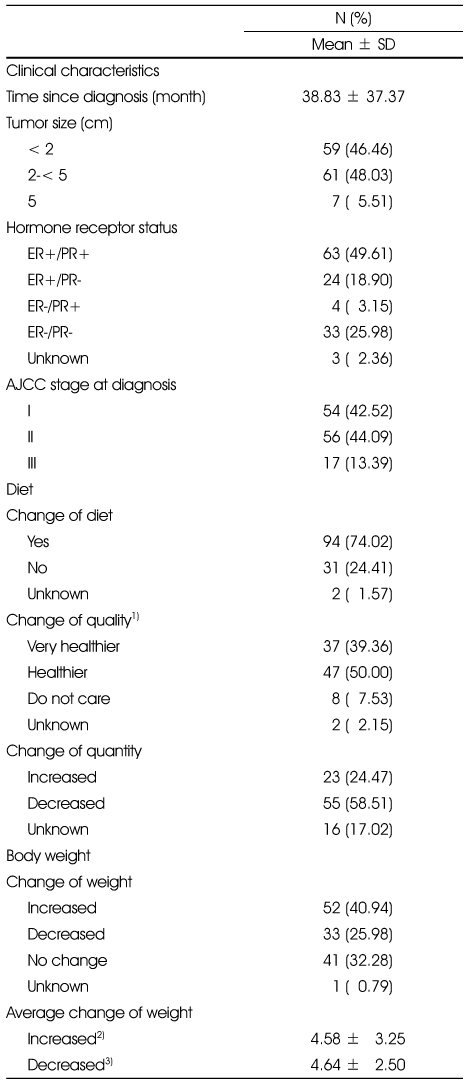
Abbreviations: SD, standard deviation; ER, estrogen receptor; PR, progesterone receptor; AJCC, American joint committee on cancer.
1) Analyzed 94 cases who changed their diet after the breast cancer diagnosis
2) Analyzed 50 cases because 2 cases did not respond to the question on average weight change
3) Analyzed 33 cases
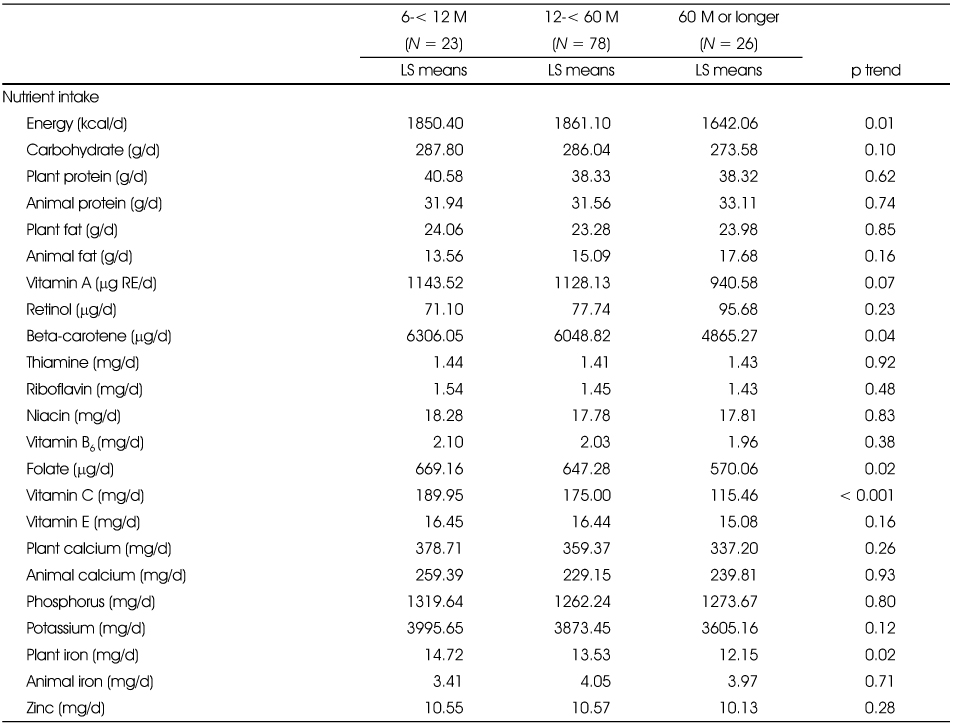
Abbreviations: M, month; LS means, least squared means.
Adjusted for age (years, continuous), body mass index (kg/m2, continuous), marital status (married or cohabitation, others), education level (middle school or less, high school or unknown, college or more), dietary supplement use (yes or no), physical activity (MET-hour per week, continuous) and total energy intake (kcal/d, continuous). For energy intake analysis, total energy intake was not adjusted.
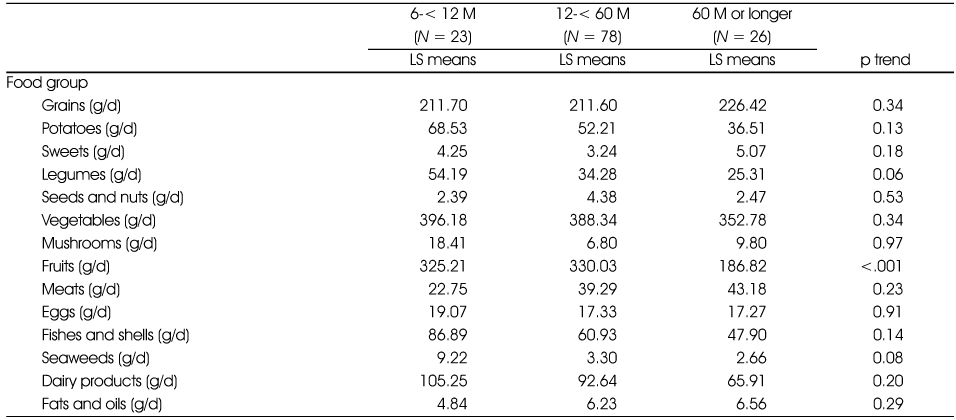
Abbreviations: M, month; LS means, least squared means.
Adjusted for age (years, continuous), body mass index (kg/m2, continuous), marital status (married or cohabitation, others), education level (middle school or less, high school or unknown, college or more), dietary supplement use (yes or no), physical activity (MET-hour per week, continuous) and total energy intake (kcal/d, continuous).
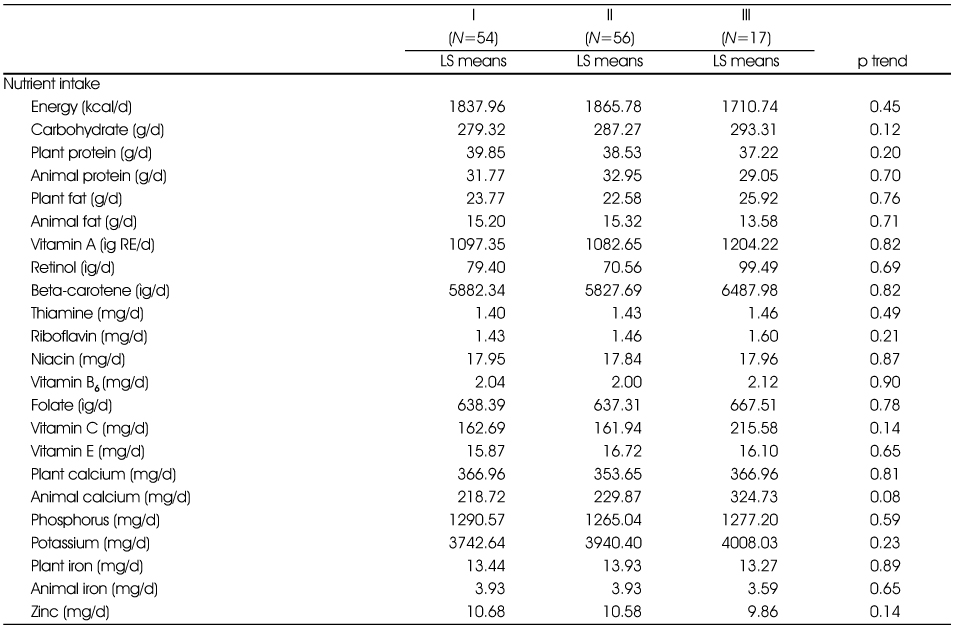
Abbreviations: LS means, least squared means.
Adjusted for age (years, continuous), body mass index (kg/m2, continuous), marital status (married or cohabitation, others), education level (middle school or less, high school or unknown, college or more), dietary supplement use (yes or no), physical activity (MET-hour per week, continuous) and total energy intake (kcal/d, continuous). For energy intake analysis, total energy intake was not adjusted.
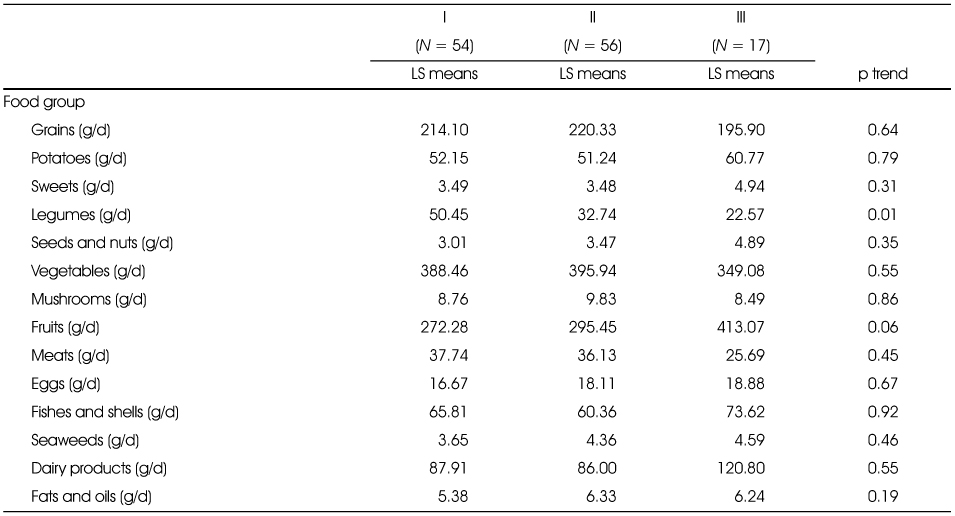
Abbreviations: LS means, least squared means.
Adjusted for age (years, continuous), body mass index (kg/m2, continuous), marital status (married or cohabitation, others), education level (middle school or less, high school or unknown, college or more), dietary supplement use (yes or no), physical activity (MET-hour per week, continuous) and total energy intake (kcal/d, continuous).
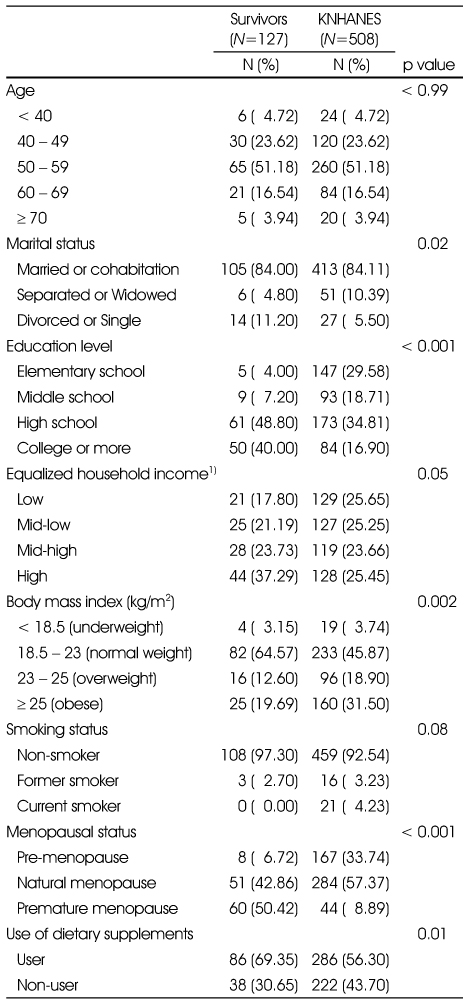
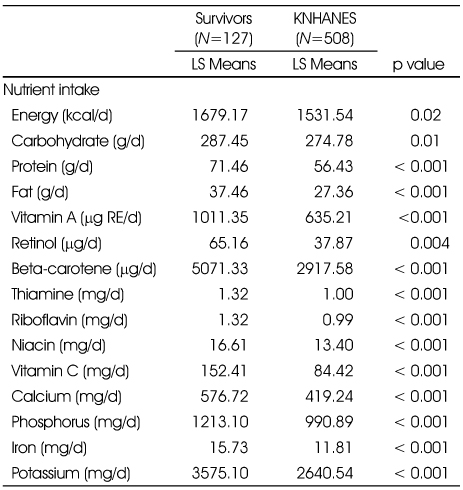
Abbreviation: LS Means, least squared means.
Adjusted for age (years, continuous), body mass index (kg/m2, continuous), marital status (married or cohabitation, separated or widowed, divorced or single, others or unknown), education level (elementary school, middle school, high school or unknown, college or more), equalized household income (low, mid-low, mid-high, high), smoking status (never-, ever-smoker, unknown), menopausal status (pre-, natural-, premature-menopause, unknown), dietary supplement use (yes or no), physical activity (vigorous and moderate, vigorous only, moderate only, no or unknown) and total energy intake (kcal/d, continuous). For energy intake analysis, total energy intake was not adjusted.
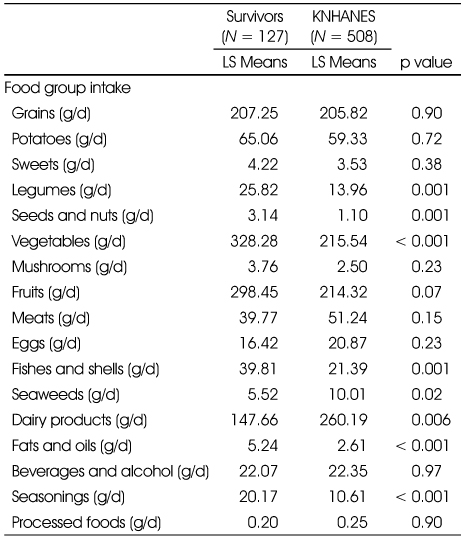
Abbreviation: LS Means, least squared means.
Adjusted for age (years, continuous), body mass index (kg/m2, continuous), marital status (married or cohabitation, separated or widowed, divorced or single, others or unknown), education level (elementary school, middle school, high school or unknown, college or more), equalized household income (low, mid-low, mid-high, high), smoking status (never-, ever-smoker, unknown), menopausal status (pre-, natural-, premature-menopause, unknown), dietary supplement use (yes or no), physical activity (vigorous and moderate, vigorous only, moderate only, no or unknown) and total energy intake (kcal/d, continuous). For energy intake analysis, total energy intake was not adjusted.
Figure & Data
REFERENCES
Citations

- Utilization of Nutrition Labels and Its Relation to Nutrient Intake among Cancer Survivors: The 2019–2021 Korea National Health and Nutrition Examination Survey
Kyujin Choi, Seyoung Son, Hee-Kyung Joh, Su-Min Jeong
Korean Journal of Family Practice.2023; 13(4): 225. CrossRef - Nutrient intakes from supplement and factors associated with supplement use among breast cancer survivors: A cross‐sectional study
Jiyoung Youn, Sihyun Park, Sihan Song, Hyeong‐Gon Moon, Dong‐Young Noh, So‐Youn Jung, Eunsook Lee, Zisun Kim, Hyun Jo Youn, Jihyoung Cho, Young Bum Yoo, Se Kyung Lee, Taisun Hyun, Jung Eun Lee
European Journal of Cancer Care.2021;[Epub] CrossRef - A Comparisons of Nutritional Intake and Diet Quality Index-International in Gynecological Cancer Survivors and Normal Women: Using the Korea National Health and Nutrition Examination Survey 2013~2016
Bo-Young Seo, Eun-Sil Her
Korean Journal of Community Nutrition.2020; 25(5): 406. CrossRef - The Effects of Utilizing Smartphone Application Peer Support on Health Behavior and Body Mass Index among Breast Cancer Survivors
Gaeun Park, Haejung Lee, Hyun Yul Kim
Journal of Korean Academy of Nursing.2019; 49(5): 550. CrossRef - Determinants of Plasma 25-Hydroxyvitamin D Concentrations among Breast Cancer Survivors in Korea
Woo-Kyoung Shin, Zisun Kim, Hyun Youn, Jihyoung Cho, Jung Lee
Nutrients.2018; 10(3): 380. CrossRef - Development of a FFQ for breast cancer survivors in Korea
Woo-kyoung Shin, Sihan Song, Eunkyung Hwang, Hyeong-Gon Moon, Dong-Young Noh, Jung Eun Lee
British Journal of Nutrition.2016; 116(10): 1781. CrossRef
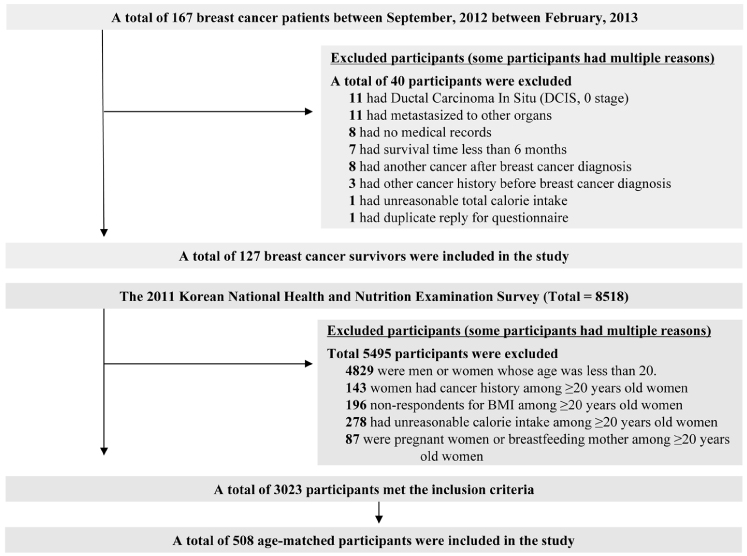
Fig. 1
Clinical characteristics and changes in diet and weight after the breast cancer diagnosis among breast cancer survivors
Abbreviations: SD, standard deviation; ER, estrogen receptor; PR, progesterone receptor; AJCC, American joint committee on cancer.
1) Analyzed 94 cases who changed their diet after the breast cancer diagnosis
2) Analyzed 50 cases because 2 cases did not respond to the question on average weight change
3) Analyzed 33 cases
Nutrient intakes according to time since surgery
Abbreviations: M, month; LS means, least squared means.
Adjusted for age (years, continuous), body mass index (kg/m2, continuous), marital status (married or cohabitation, others), education level (middle school or less, high school or unknown, college or more), dietary supplement use (yes or no), physical activity (MET-hour per week, continuous) and total energy intake (kcal/d, continuous). For energy intake analysis, total energy intake was not adjusted.
Food group intake according to time since surgery
Abbreviations: M, month; LS means, least squared means.
Adjusted for age (years, continuous), body mass index (kg/m2, continuous), marital status (married or cohabitation, others), education level (middle school or less, high school or unknown, college or more), dietary supplement use (yes or no), physical activity (MET-hour per week, continuous) and total energy intake (kcal/d, continuous).
Nutrient intakes according to cancer stage
Abbreviations: LS means, least squared means.
Adjusted for age (years, continuous), body mass index (kg/m2, continuous), marital status (married or cohabitation, others), education level (middle school or less, high school or unknown, college or more), dietary supplement use (yes or no), physical activity (MET-hour per week, continuous) and total energy intake (kcal/d, continuous). For energy intake analysis, total energy intake was not adjusted.
Food group intake according to cancer stage
Abbreviations: LS means, least squared means.
Adjusted for age (years, continuous), body mass index (kg/m2, continuous), marital status (married or cohabitation, others), education level (middle school or less, high school or unknown, college or more), dietary supplement use (yes or no), physical activity (MET-hour per week, continuous) and total energy intake (kcal/d, continuous).
Comparison of socio-demographic factors between breast cancer survivors and age-matched KNHANES population
1)
Comparison of nutrient intake between breast cancer survivors and age-matched KNHANES population
Abbreviation: LS Means, least squared means.
Adjusted for age (years, continuous), body mass index (kg/m2, continuous), marital status (married or cohabitation, separated or widowed, divorced or single, others or unknown), education level (elementary school, middle school, high school or unknown, college or more), equalized household income (low, mid-low, mid-high, high), smoking status (never-, ever-smoker, unknown), menopausal status (pre-, natural-, premature-menopause, unknown), dietary supplement use (yes or no), physical activity (vigorous and moderate, vigorous only, moderate only, no or unknown) and total energy intake (kcal/d, continuous). For energy intake analysis, total energy intake was not adjusted.
Comparison of food group intake between breast cancer survivors and age-matched KNHANES population
Abbreviation: LS Means, least squared means.
Adjusted for age (years, continuous), body mass index (kg/m2, continuous), marital status (married or cohabitation, separated or widowed, divorced or single, others or unknown), education level (elementary school, middle school, high school or unknown, college or more), equalized household income (low, mid-low, mid-high, high), smoking status (never-, ever-smoker, unknown), menopausal status (pre-, natural-, premature-menopause, unknown), dietary supplement use (yes or no), physical activity (vigorous and moderate, vigorous only, moderate only, no or unknown) and total energy intake (kcal/d, continuous). For energy intake analysis, total energy intake was not adjusted.
Abbreviations: SD, standard deviation; ER, estrogen receptor; PR, progesterone receptor; AJCC, American joint committee on cancer. 1) Analyzed 94 cases who changed their diet after the breast cancer diagnosis 2) Analyzed 50 cases because 2 cases did not respond to the question on average weight change 3) Analyzed 33 cases
Abbreviations: M, month; LS means, least squared means. Adjusted for age (years, continuous), body mass index (kg/m2, continuous), marital status (married or cohabitation, others), education level (middle school or less, high school or unknown, college or more), dietary supplement use (yes or no), physical activity (MET-hour per week, continuous) and total energy intake (kcal/d, continuous). For energy intake analysis, total energy intake was not adjusted.
Abbreviations: M, month; LS means, least squared means. Adjusted for age (years, continuous), body mass index (kg/m2, continuous), marital status (married or cohabitation, others), education level (middle school or less, high school or unknown, college or more), dietary supplement use (yes or no), physical activity (MET-hour per week, continuous) and total energy intake (kcal/d, continuous).
Abbreviations: LS means, least squared means. Adjusted for age (years, continuous), body mass index (kg/m2, continuous), marital status (married or cohabitation, others), education level (middle school or less, high school or unknown, college or more), dietary supplement use (yes or no), physical activity (MET-hour per week, continuous) and total energy intake (kcal/d, continuous). For energy intake analysis, total energy intake was not adjusted.
Abbreviations: LS means, least squared means. Adjusted for age (years, continuous), body mass index (kg/m2, continuous), marital status (married or cohabitation, others), education level (middle school or less, high school or unknown, college or more), dietary supplement use (yes or no), physical activity (MET-hour per week, continuous) and total energy intake (kcal/d, continuous).
1)
Abbreviation: LS Means, least squared means. Adjusted for age (years, continuous), body mass index (kg/m2, continuous), marital status (married or cohabitation, separated or widowed, divorced or single, others or unknown), education level (elementary school, middle school, high school or unknown, college or more), equalized household income (low, mid-low, mid-high, high), smoking status (never-, ever-smoker, unknown), menopausal status (pre-, natural-, premature-menopause, unknown), dietary supplement use (yes or no), physical activity (vigorous and moderate, vigorous only, moderate only, no or unknown) and total energy intake (kcal/d, continuous). For energy intake analysis, total energy intake was not adjusted.
Abbreviation: LS Means, least squared means. Adjusted for age (years, continuous), body mass index (kg/m2, continuous), marital status (married or cohabitation, separated or widowed, divorced or single, others or unknown), education level (elementary school, middle school, high school or unknown, college or more), equalized household income (low, mid-low, mid-high, high), smoking status (never-, ever-smoker, unknown), menopausal status (pre-, natural-, premature-menopause, unknown), dietary supplement use (yes or no), physical activity (vigorous and moderate, vigorous only, moderate only, no or unknown) and total energy intake (kcal/d, continuous). For energy intake analysis, total energy intake was not adjusted.

 KSCN
KSCN

 PubReader
PubReader Cite
Cite


